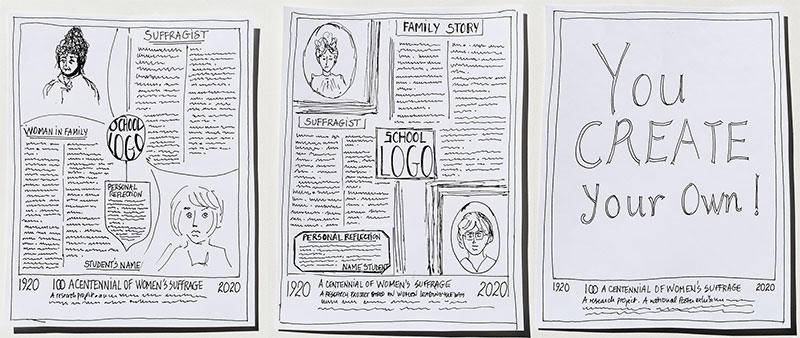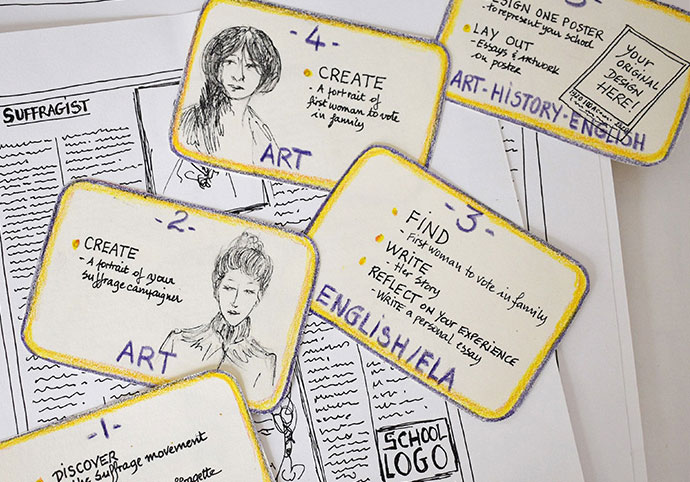STEP 1: RESEARCH AND WRITE A BIOGRAPHY OF AN HISTORICAL SUFFRAGE CAMPAIGNER

Detail from Mireille Miller's Women Leading the Way: Suffragists & Suffragettes.
HISTORY
GOAL – Students will research one of the women depicted in the painting Women Leading the Way: Suffragists & Suffragettes; alternatively, they may choose to research a female suffrage campaigner from their own state who is not represented in the painting. They will be challenged to think critically in order to write a revealing biographical essay of that person’s life and her contribution to the advancement of women’s voting rights or human rights. They will cross-reference primary source material carefully, to do so.INTRODUCTION – Study the Civil War, Abraham Lincoln, the Emancipation Proclamation and the anti-slavery movement. From there, segway into the Suffrage Movement. Focus efforts on teaching the students about the importance of thorough research when writing about a historical figure.
Three areas of biographical research should be considered: Biography, Context and Contribution. All content, to be organically meshed, will run from 500 to 750 words in length.
As an option, content can be equally divided into columns under each of these headings.
BIOGRAPHY – An overview of each woman’s life based on the students’ own interpretation and analysis of the basic facts, events, influences and anecdotes that shaped that individual. This should be a compelling story.
CONTEXT – Define the period in which the woman lived and worked. Consider all aspects: historical, political, cultural, intellectual, and socio-economic. “Context” will inform both the women’s biographies and their contributions.
For example, in the U.S., the ratification of the 19th Amendment met with strong opposition. Why? How did racism and Jim Crow laws adversely affect the enfranchisement of women?
CONTRIBUTION – Define the women’s impact and legacy of their accomplishments. Questions to think about:
• What impact did society have on these particular women? How did their historical, cultural, economic and political backgrounds inform their development and their actions?
• How did they advance various issues / causes in their own field, time, and for future generations?
• What motivated them to take risks, to challenge the status quo, and to contribute to their time?
• How did these women impact the lives of their contemporaries?
• Were they aware of being role models, of paving the way for generations to come?
• What did they sacrifice to achieve their goals?
• How did their contributions help change the course of the lives of people today?
ADDITIONAL RESOURCES:
• EDSITEment! Comprehensive Lesson Plan
• Helpful Links
• Suffrage Timeline
STEP 2: CREATE A PORTRAIT OF YOUR SUFFRAGE CAMPAIGNER

Student portraits of Ida Wells-Barnett, Christabel Pankhurst and Crystal Eastman.
ART COMPONENT
GOAL – Students will create expressive portraits of historical suffrage campaigners, that will show not only the likeness of their subjects, but also communicate some insight into their personality or character.ACTIVITIES – Introduce the theme of portraiture and identity by asking students to pair up and take pictures of each other (or selfies). Next, break up your class into small groups of four, and ask them to analyze and compare the photographs within their groups. To guide their discussion, provide a list of questions to answer:
• What is a portrait?
• What does it reveal or conceal of a person’s identity, social status, mood or character?
• What makes a good portrait?
• What or who gives meaning to a portrait?
Following the discussion, ask your students to take a second picture of their teammate and compare it with the first.
• How does the second portrait differ from the first?
• What did it show that perhaps was not revealed in the first portrait?
• What did they learn?
ADDITIONAL RESOURCES:
• Lesson Plan Number One (Artsy for Education)
• Looking at Portraits: Lessons and Ideas for Discussion
STEP 3: CREATE A PERSONAL HISTORY

Vintage image of "Votes for Women" campaign.
ENGLISH / ELA
GOAL – Through personal interviews and documentation – such as photographs, letters, journals, oral history and artifacts – students will research the first woman who was granted or denied the right to vote within their own family, and summarize her life story, along with her sentiments at the time. If it is not possible to find the first woman who was granted or denied the right to vote in their own family, students may choose a subject outside of their family.WRITE HER STORY – Connect family stories to history. In telling her story, students should consider the historical context of that family member’s experience, and try to compare it with their own. Essays should run 300 to 400 words in length.
REFLECT – Each student will write a personal, reflective essay on their experience of having researched these extraordinary women, and the value of connecting their own family experiences to history. Reflections should address why voting matters at all levels: local, state and federal. Essays should run 250 to 350 words in length.
HELPFUL QUESTIONS:
• When and where was she born?
• How many siblings did she have?
• What was her place in the family?
• How was her childhood?
• What were her responsibilities or chores in the family?
• Did she go to school, and how much schooling was she able to have?
• Did she remember the first time she voted?
• What was the political situation in her country when she was growing up (because we are an international community)?
• Did she have to fight for women’s rights?
ADDITIONAL RESOURCES
Learning about Race and Racism Through Storytelling and Art
STEP 4: CREATE A PORTRAIT OF THE FIRST WOMAN TO VOTE IN YOUR FAMILY

Student portraits of the first women in their family to vote.
ART
GOAL – Using drawing techniques, collage, photomontage, sculpture, painting or digital media, create a portrait of the women in their families that they chose to write about.Recall the outcomes from the first art lesson, and reiterate the questions posed to the students:
• What is a portrait?
• What does it reveal or conceal of a person’s identity, social status, mood or character?
• What makes a good portrait?
• What or who gives meaning to a portrait?
All artwork must be sized to fit on a poster with the three essays. The final poster dimensions must be 29 inches tall by 23 inches wide.
ADDITIONAL RESOURCES
• Looking at Portraits: Lessons and Ideas for Discussion
STEP 5: DESIGN A POSTER

Sample poster styles.
ART / HISTORY / ENGLISH
GOAL – Using a poster template that we will supply at the start of the project, each participating class will personalize it by creating a design that best represents the values of their institution. The design can be planned as a contest within each school. The layout of the essays, the artwork and school logo will be the responsibility of the students and leaders of the project within the school.The final poster dimensions must be 29 inches tall by 23 inches wide.
In addition to the National Poster Exhibition, we encourage each school to hold a show of their students’ work in their local community.
The poster template supplied will be used for the National Poster Exhibition, to be held in March 2020. (Schools may use that template for the local exhibition of their students’ work, or feel free to display the work differently.)


